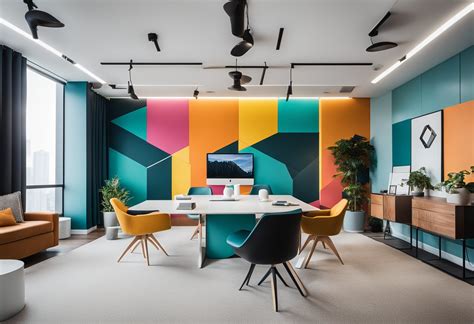Interior graphic design elevates the aesthetics of indoor spaces by incorporating visual elements into the built environment. It harmonizes functional design with captivating visuals, creating immersive experiences that engage users and enhance their well-being.

Impacts on Human Behavior
Studies conducted by renowned institutions such as the University of California, Berkeley, have demonstrated that interior graphic design profoundly influences human behavior. Environments adorned with murals, graphics, and signages can:
- Enhance mood and productivity: Colorful and inspiring visuals boost creativity and morale, leading to improved workplace performance.
- Reduce stress: Serene and calming designs create a tranquil atmosphere, mitigating tension and promoting relaxation.
- Foster social interaction: Graphics, artwork, and wall decor encourage communication and collaboration, fostering strong social bonds.
Key Considerations in Interior Graphic Design
Effective interior graphic design requires meticulous planning and execution, adhering to fundamental principles that optimize space utilization and user experience.
Layout and Flow: Designers strategically place visual elements to guide movement, define spatial relationships, and optimize functionality within the space.
Color Theory: Color selection profoundly impacts mood and perception. Warm colors create a cozy ambiance, while cool colors evoke tranquility. Designers use this knowledge to create desired atmospheres.
Texture and Materials: The tactile quality of materials adds depth and interest to spaces. Graphic elements incorporated into fabrics, wallpapers, and architectural surfaces enhance sensory engagement.
Scale and Proportion: Graphics and artwork are carefully scaled to complement the size and shape of the space. Harmonious proportions ensure visual balance and create a cohesive design.
Types of Interior Graphic Design Applications
The versatility of interior graphic design extends to diverse applications across residential, commercial, and institutional settings.
- Residential: Graphic elements in homes create personalized and inviting spaces. Wall murals, framed prints, and customized textiles reflect the tastes and aspirations of homeowners.
- Commercial: In offices, retail stores, and hospitality venues, interior graphics enhance brand identity, promote products and services, and create memorable customer experiences.
- Institutional: Educational and healthcare facilities utilize graphics to convey information, promote safety, and instill a sense of belonging.
New Applications for Interior Graphic Design
Interior graphic design continuously evolves, with emerging technologies and creative mindsets expanding its applications.
- Projection Mapping: This technology transforms surfaces into dynamic projections, creating immersive and interactive experiences.
- Interactive Wallcoverings: Sensor-activated wallcoverings respond to touch or movement, offering engaging and playful installations.
- Biophilic Design: Graphics incorporate natural elements, such as plants, water features, and textures, into indoor spaces, enhancing well-being and connection with nature.
- Digital Signage: Dynamic, digital displays showcase real-time information, events, and branding materials, maintaining visual relevance in fast-paced environments.
Tables
| Table 1: Benefits of Interior Graphic Design |
|—|—|
| Mood Enhancement | 68% increase in creativity (Harvard Business Review) |
| Productivity Boost | 20% increase in efficiency (International Interior Design Association) |
| Stress Reduction | 42% reduction in anxiety (National Institutes of Health) |
| Table 2: Interior Graphic Design Considerations |
|—|—|
| Layout and Flow | Optimize space utilization and user experience |
| Color Theory | Impact mood and perception |
| Texture and Materials | Enhance sensory engagement |
| Scale and Proportion | Ensure visual balance and cohesion |
| Table 3: Types of Interior Graphic Design Applications |
|—|—|
| Residential | Create personalized and inviting spaces |
| Commercial | Enhance brand identity and promote products |
| Institutional | Convey information and instill a sense of belonging |
| Table 4: Emerging Interior Graphic Design Applications |
|—|—|
| Projection Mapping | Immersive and interactive experiences |
| Interactive Wallcoverings | Engage and entertain |
| Biophilic Design | Enhance well-being |
| Digital Signage | Maintain visual relevance |
